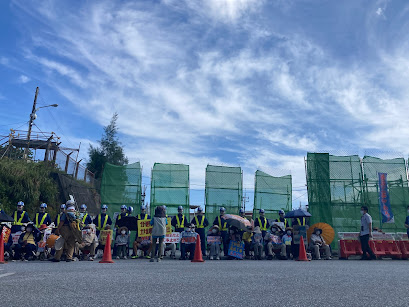It's the U.S. military's turn to express concern over Henoko base project
Finally, according to Okinawan and Japanese media outlets, on November 7, 2023, responding to reporters' questions, a top official of the U.S. military in Okinawa expressed the military's concerns over the operability of the Henoko base due to the extremely soft seafloor on which the base is being constructed. The official also expressed that the U.S. military would like to continue to use the Futenma Air Station because of operational deficiencies that the Henoko base (even if completed) will have. Most notably among deficiencies, the runways of the Henoko base, which will be 1,800 meters, are too short for the military's intended operations. The official also expressed concerns that the target date of completion, 2037, was calculated without considering delays due to weather conditions (read typhoons). Regrettably, the official did not comment on furhter environmental destruction the seafloor reinforcement work is expected to cause.
 |
| Image Source: QAB Ryukyu Asahi Broadcasting |
A top official of the Okinawa Area Coordinator explained these concerns to Japanese media reporters in a workshop held in Okinawa on Nov. 7. The name of the official is not mentioned in the Japanese media reports (probably at the request of the Kanbu).
The issues that the top official discussed have been raised in reports from U.S. Congress and U.S. think tanks since the Tokyo government officially acknowledged the problems of soft seafloor in late 2018. So, these issues themselves are nothing new. What is new and critical is that the U.S. military, which will have to use this sinking airfield, has come clean on these issues for the first time, and this has come as the “proxy execution” lawsuit between the Okinawa Prefectural government and the Tokyo government is approaching a final verdict in the High Court. This new development has a lot of implications for the Japanese government and Court.
OEJP welcomes this new development because we have been working hard for quite some time to get the DoD to come clean on these issues. Last year, we sent a letter of request to U.S. Congress members to review the issues and press the DoD to do so as well. About one hundred organizations and groups, domestic and international, and some 40 U.S. elected officials at state and municipality levels joined the letter. This September, OEJP filed FOIA requests with the DoD to release its analysis and evaluation of the soft seafloor issues. Our friends and colleagues in Japanese and U.S. civil societies have taken action to join and support the OEJP’s FOIA requests.
Now, OEJP plans to file a new FOIA request with the DoD to prove the information source (probably in the form of detailed analysis and evaluation of the soft seafloor issues), which the Kanbu of the Okinawa Area Coordinator used to explain the DoD’s concerns to the Japanese media reporters.
* Previously, in the first sentence of the first paragraph, the wording "the U.S. military expressed" was used. It has been corrected and the expression "responding to reporters' questions, a top official of the U.S. military in Okinawa expressed" is used. Accordingly, corrections have been made to other sentences. Jan. 09, 2024.


